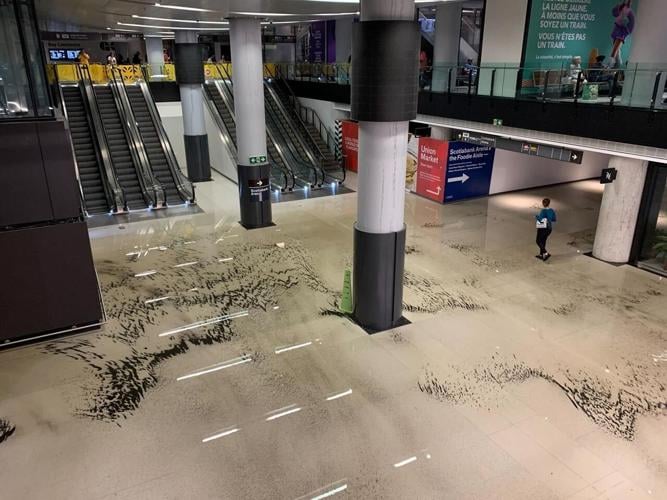TorontoŌĆÖs beaches could be contaminated for up to two weeks by human and animal waste brought in by Tuesday’s storm, ║ŻĮŪ╔ńŪ°╣┘═°Public Health said, after three ║ŻĮŪ╔ńŪ°╣┘═°water treatment plants were forced to discharge a combined 1.3 billion litres of partially treated sewage.┬Ā
ŌĆ£Flooding can affect beach water quality by increasing the presence of E.coli and other harmful organisms from animal and human waste in beach water,ŌĆØ said TPH in an email to the Star. ŌĆ£This contamination poses a risk of infections and illnesses for those who swim in or come into contact with the water.ŌĆØ
Based on historical post-storm data, it could take between five days and two weeks for E.coli levels to drop. Beaches closer to rivers, such as Marie Curtis in Etobicoke, can take longer to recover.┬Ā
At most beaches, sunlight should disinfect much of the sewage over the next two days, the city said in an email to the Star. The city posts frequent beach water quality updates advising people of their bacteria content.
Going for a swim before it’s safe could lead to ear, eye, nose, throat and skin infections, as well as gastrointestinal issues if, heaven forbid, one were to drink the wastewater.┬Ā
Beaches weren’t the only parts of ║ŻĮŪ╔ńŪ°╣┘═°that the storm affected. Streets, transit hubs and┬Āeven Drake’s Bridal Path mansion were all soaked with suspiciously brown floodwater.┬Ā
Factors that raise the risk of waste flooding into your home or driveway include its┬Āproximity to Lake Ontario, whether your street dips down in a valley or “bowl” versus being on higher ground and proximity to a sewer that the storm pushed beyond capacity.
“Everyone should be mindful of health and safety with a flooded basement or home. Homeowners may be exposed to water-borne diseases, corrosive cleaning agents and irritants found in leftover sludge from a flooded basement,” the city said. “The water surcharging on the street picks up the material from the storm sewer and the ground, which is why water entering homes may be brown or discoloured.”
While it is difficult to quantify how much feces and other unmentionable things escaped into ║ŻĮŪ╔ńŪ°╣┘═°streets Tuesday, the city shared that as of Wednesday afternoon, it had received 1,043 requests for block sewer service connections, ostensibly to relieve areas of wastewater flow. Of these requests, only 92 had been resolved by mid-afternoon.
One contributing factor to Toronto’s problem is that it is full of “combined sewers,” which, like the cloaca of a hen, are used for everything. They carry both sewage and stormwater.
Most of the time, the city said, these combined sewers carry a mix of rain and sewage to the city’s wastewater treatment plants. But during periods of intense rainfall, the system can’t handle the volume of stormwater it gets, so it overflows.
“We have aging infrastructure that can no longer handle the volume of effluent,” said Gregary Ford, vice president of the water advocacy group Swim Drink Fish Canada. “What happened yesterday went above and beyond, we had sewers backing up into our streets, into our roads, into our waterfronts. Untreated sewage went into basements, into the TTC, on to our roadways, and eventually into our rivers and our beaches.”┬Ā
Ford said if Torontonians want to stop living in a city that risks overflowing with poop every time it rains heavily, they should connect with advocacy groups and local politicians, so that they know there is public support for initiatives to fix the sewers.┬Ā
Unfortunately, catching a bug from wading in stormwater is just one of the myriad health issues that can flow from floods.┬Ā
that heavy rains can also contaminate drinking water by overwhelming drainage, water treatment and sewage systems.┬Ā
Despite the rain forcing out the equivalent of about 500 Olympic-size pools worth of treated sewage,┬Āthe city confirmed to the Star Tuesday that Toronto’s drinking water was not tainted.┬Ā
Further opportunities for floodwater to poison us occur if itŌĆÖs able to mix with pollutants such as agricultural waste, chemicals, raw sewage or metal, PHAC said, which can then slip into waterways that supply drinking water.┬Ā
If water contamination wasnŌĆÖt enough to worry about, consider also that floods can make the air in your home more toxic.┬Ā
ŌĆ£Flooded buildings can stay damp even after floodwater has receded, which can create a perfect environment for bacteria and mould growth that can lead to dangerously poor indoor air quality,ŌĆØ said PHAC. ŌĆ£Breathing spores from mould and fungi can cause allergic reactions and breathing problems such as coughing, wheezing, and asthma attacks.ŌĆØ
Then there is the cascade of health issues associated with power outages, which affected about 170,000 Torontonians during the storm yesterday.┬Ā
ŌĆ£When power is lost for extended periods, the food in your refrigerator and freezer may become unsafe to eat as harmful bacteria can grow,ŌĆØ said TPH. ŌĆ£Consuming this food can cause food-borne illnesses, with symptoms such as nausea, vomiting, diarrhea, and fever.ŌĆØ
Losing power can also disrupt indoor ventilation systems working on gas-powered appliances. If these fail, it can lead to carbon monoxide poisoning.
Floodwater is also an ideal breeding ground for mosquitoes. Floods grow their population, thereby helping spread diseases, such as West Nile virus, which a batch of ║ŻĮŪ╔ńŪ°╣┘═°mosquitoes just tested positive for on Tuesday for the first time this year.






























To join the conversation set a first and last name in your user profile.
Sign in or register for free to join the Conversation